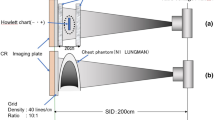Abstract
To achieve significant dose reduction without compromising diagnostic efficacy, it is important to understand the effects of exposure reduction on image quality, a concept that is often mentioned but not well defined in the imaging literature. Studies to assess subjective image quality for digital radiography (DR) demonstrate wide variability among radiologists and technologists, resulting in substantial variability in the determination of acceptable image quality and optimal radiation exposure required to obtain a high-quality radiograph. In addition to improving detector technology and image processing techniques and tailoring exposure to the exam type and patient body habitus, it is possible to take advantage of informatics-based and psychoperceptual approaches. These can be used to establish the relative trade-offs among patient exposure, perceived image quality, and diagnostic efficacy. Innovations such as automated quality assessment of digital radiographs, use of a mathematical model of the human visual system to predict the perceived impact of lower radiation exposure, the creation of a quality-assessment database of images, and better definition and training of radiologists in the determination of image quality can help to reduce variability in assessment and facilitate reductions in dose while minimizing negative effects on image quality.



Similar content being viewed by others
References
Wikipedia (2010) Image quality. Available via http://en.wikipedia.org/wiki/Image_quality. Accessed 20 Oct 2010
Council of European Communities (1996) European guidelines on quality criteria for diagnostic radiographic images, Rep EUR 16260 EN. Office for Official Publications of the European Communities, Luxembourg
Krupinski EA, Johnson J, Roehrig H et al (2003) Using a human visual system model to optimize soft-copy mammography display: influence of MTF compensation. Acad Radiol 10:1030–1035
Johnson JP, Lubin J, Nafziger JS et al (2005) Channelized model observer using a visual discrimination model. Proc SPIE 5749:199
Barrett HH (1990) Objective assessment of image quality: effects of quantum noise and object variability. J Opt Soc Am 7:1266–1278
Barrett HH, Yao J, Rolland JP et al (1993) Model observers for assessment of image quality. Proc Nat Acad of Sci USA 90:9758–9765
Aanestad M, Edwin B, Mårvik R (2003) Medical image quality as a socio-technical phenomenon. Methods Inf Med 42:302–306
Cosman PC, Gray RM, Olshen RA (1994) Evaluating quality of compressed medical images: SNR, subjective rating, and diagnostic accuracy. Proc IEEE 82:919–932
Siegel EL, Khorasani R (2007) To compress or not to compress: a compressed debate. J Am Coll Radiol 1:981–983
Peli E (1995) Vision models for target detection and recognition, vol 2. World Scientific Publishing, Singapore
Stedman’s Electronic Medical Dictionary 7.0 (2006) Lippincott Williams & Wilkins, Philadelphia, PA, USA
Radiological Society of North America (2010) RadLex: a lexicon for uniform indexing and retrieval of radiology information resources. Available via http://www.rsna.org/radlex/. Accessed 22 Oct 2010
International Labour Office (ILO) (2002) Guidelines for the Use of the ILO International Classification of Radiographs of Pneumoconioses, Revised Edition 2000 (Occupational Safety and Health Series, No. 22). International Labour Office, Geneva
Reiner BI (2009) Automating quality assurance for digital radiography. J Am Coll Radiol 6:486–490
Reiner BI, Siegel E, Foos D et al (2007) Quantitative analysis of digital radiography QA deficiencies. In: Abstracts of the Annual Meeting of the Society for Imaging Informatics in Medicine, Providence, RI, USA
Chen JJ, Reiner B, Siegel E et al (2008) Beauty in the eyes of the beholder: image quality perceptions for digital radiography. In: Abstracts of the Annual Meeting of the Society for Imaging Informatics in Medicine, Seattle, WA, USA
Nguyen K, Reiner B, Sehnert J et al (2007) Multi-institutional analysis of retake rates for digital chest radiography: comparison of portable vs. erect chest radiographs. In: Abstracts of the Radiological Society of North America Annual Meeting, Chicago, IL, USA
Acknowledgements
We want to thank Dr. Nancy Knight for her invaluable assistance in editing this manuscript and Paul Nagy for contributing the spider chart.
Author information
Authors and Affiliations
Corresponding author
Rights and permissions
About this article
Cite this article
Shet, N., Chen, J. & Siegel, E.L. Continuing challenges in defining image quality. Pediatr Radiol 41, 582–587 (2011). https://doi.org/10.1007/s00247-011-2028-0
Received:
Revised:
Accepted:
Published:
Issue Date:
DOI: https://doi.org/10.1007/s00247-011-2028-0




